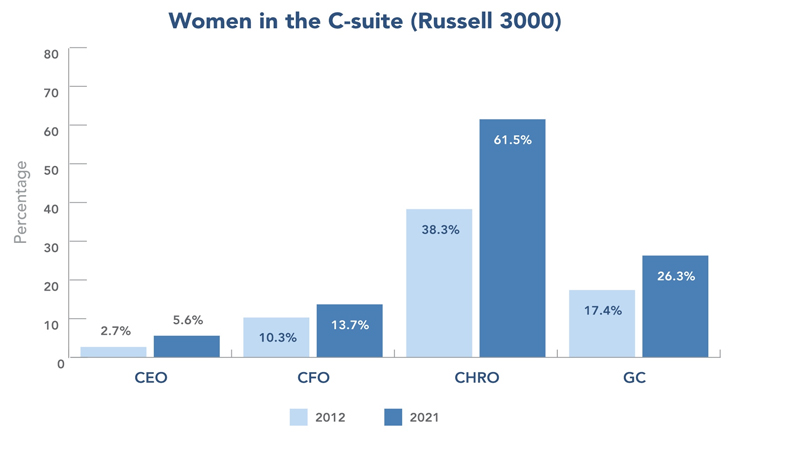More than one-quarter of board seats in the Russell 3000 now belong to women, according to a new report from Equilar – increasing to 25.2% from 15% just five years ago; but there’s still a long way to go to reach parity.
The Equilar Gender Diversity Index (GDI) has crossed the halfway mark for the first time, reaching 0.50 as of June 30, 2021, where 1.0 represents gender parity on Russell 3000 boards. Nearly 47% of directors added to boards in Q2 were women. In addition, the number of boards that have reached gender parity jumped 20% in Q2 2021, up from 70 to 84; and the number of boards represented by 40% to 50% women increased 11.8% from 186 to 208. In short, approximately 10% of the boards across the entire index now have at least 40% women. Furthermore, the number of boards with zero women fell to 118, or 4.1% of the Russell 3000, which was down from 4.9% in Q1.
A LONG WAY TO PARITY
“Importantly, the number of new male and female directors added in Q2 is almost at parity,” said Susan Angele, Senior Advisor, Board Governance at The KPMG Board Leadership Center. “The key to continuing progress is for boards to avoid a ‘one and done’ approach; and insist on a diverse slate including a mix of qualified candidates across gender, race, ethnicity and sexual orientation for every board search, not just those categorised as ‘diversity searches’.”
Still, women have a long way to go to reach parity. One major issue holding back the increased prevalence of women on boards is their ability to access the pipeline leading to director positions. While there are thousands of qualified women in the current workforce, a narrow perception of what it means to be “board-ready” often limits the recruitment process.

EXPANDING BOARD-READY WOMEN PIPELINE
“Progressive and ultimately sustained board gender diversity requires that workforce diversity also improves,” said Hannah Orowitz, Senior Managing Director, Corporate Governance at Georgeson. “The focus on workforce diversity as a key issue over the last year has led companies to develop strategies and initiatives to increase diverse representation in senior positions, which will further expand the pipeline of board-ready women.”
For example, the number of women in C-suite positions continues to rise, but they are often in roles that are not as commonly sought after for board experience. Just 5.6% of CEO positions and 13.7% of CFO positions in the Russell 3000 belonged to women in 2021. Though these figures have risen over the past 10 years – from 2.7% of CEOs and 10.3% of CFOs in 2012; that pool of candidates remains limited.

COMMON C-SUITE ROLES FOR WOMEN
The C-suite roles women most commonly hold at Russell 3000 companies are human resources, administration, GC/chief legal officer, marketing and accounting. In 2021, more than 60% of chief human resources officer (CHRO) roles in the Russell 3000 belonged to women, up from 38.3% in 2012. This by far outpaces the role with the next largest share – women held 39.2% of the chief administrative officer roles in the Russell 3000 in 2021; more than doubling from 19% in 2012.
These trends may indicate why women executives are not necessarily on the fast track to achieve board positions. The move to a CEO position from CHRO or GC isn’t as common as from the CFO or COO. If women continue to be limited to certain roles within the C-suite, that will impact their ability to ascend to the top corporate position as well as their ability to contend for sought-after board roles in mid-career as well as after retirement. In fact, a recent UK report, from executive recruitment and diversity consultancy Green Park, also found that Britain’s female and ethnic minority business leaders remain largely concentrated in functions such as HR, diversity, marketing or communications, which are less likely to lead to C-suite roles.

ACCELERATING WOMEN ON BOARDS
Increasing numbers are important to acknowledge in and of themselves, but they shine a light even more starkly on the same issue that the GDI figures show. Women make up more than half the corporate workforce, yet only one C-level position at US public companies has achieved gender parity.
As board diversity continues to be a fraught political topic, Nasdaq’s recent proposal to the SEC, approved on 6 August 2021, is likely to have an outsized impact on board diversity initiatives in a way that previous legislative mandates have not achieved completely. These developments, along with other external pressure on boards from key stakeholders, could certainly accelerate the pace of women on boards in the near future.
Click here for more information about the report.







































